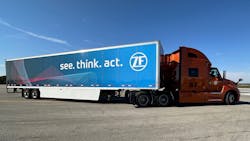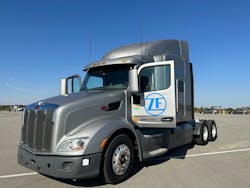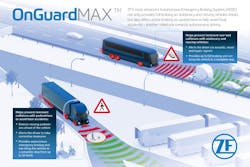ZF shows off EPS and ADAS technologies at vehicle testing site
EAST LIBERTY, Ohio—Fleet safety technologies like advanced driver assistance systems (ADAS)—coupled with the nationwide push for zero-emission trucks—are creating seismic shifts in commercial vehicle development. But when it comes to the pace at which these technologies are brought to market, fleets have the final say.
With that in mind, after ZF’s 2020 acquisition and integration of Wabco, the global technology company formed a commercial vehicle solutions (CVS) division in January. To support that development in North America, ZF has expanded its presence within the Transportation Research Center (TRC) here outside Columbus. The 16,000-sq.-ft. ZF Test and Development Hub houses the equipment, technology, office space, and 7.5 miles of test track for ZF's latest electrification, ADAS, anti-lock braking system, and steering technologies.
The thought behind the Wabco deal, according to Julien Plenchette, head of ZF’s CVS division for the Americas, is adding the skill sets needed to address how emerging technologies are changing the way braking, steering, and powertrain components and parts work together.
ZF also is leveraging insights from a new fleet advisory board to better understand North American fleet needs and identify new technologies that could help improve fleet operations.
“There is a deep need to understand what their business will be and how it will align with technology,” Plenchette told trade media during an Oct. 11 ZF Technology Day event here at the TRC.
“The pace at which we’re bringing these technologies to market depends on each fleet; some are a little bit more cautious on which powertrain will be the powertrain of choice,” Plenchette added. “It’s also important for us to think about how long it takes to develop these technologies and how much investment we put into engineering and innovation to get those technologies ready. In 2026 and 2027, we expect to see a high volume of development.”
During the Technology Day event, ZF displayed its new electric power steering (EPS) system and the supplier’s latest ADAS suite of safety technologies. Also on display was ZF’s PowerLine 8-speed automatic transmission, which is expected to launch in spring 2023. Suited for the medium-duty truck segment, PowerLine is expected to achieve fuel savings of up to 10% and 30% quicker gearshifts than automated transmissions, according to ZF.
And to address the demand for an electrified pickup truck solution, ZF has created an eBeam axle, a drop-in, electrified axle that provides 400-volt and 800-volt architectures for both OEMs and pickup truck customers.
Electric power steering
Out on one of the test tracks of the 4,500-acre testing facility on Oct. 11, media experienced firsthand ZF’s new EPS system, which the supplier refers to as a building-block technology for electrification and autonomous trucking.
“This is the next step for us towards steer by wire—both for electrification and to simplify the overall steering system,” Plenchette said. “It is not necessarily only for electric vehicles; we see it as an evolution for current traditional powertrains and electric powertrains.”
For newer, more advanced trucks coming out, ZF is designing a linear system that fits on the axle and that will require an independent front suspension. Harter added ZF will have both rotary and linear variants available in the next few years.
“This makes sense when we start talking about battery-electric vehicles, but there is also a huge savings for diesel applications, specifically for companies looking to reduce greenhouse gas emissions,” Harter pointed out.
Maneuvering between cones in a Class 8 Pete tractor equipped with EPS was as seamless as driving a passenger car. As vehicle speed increased along the track, the steering stiffened up a bit to accommodate road feel. In some applications, fleets can further adjust that road feel based on driver preference.
Read more: ZF advances automated, electric technologies for commercial vehicles
When discussing the evolution of electric power steering, Dan Williams, ZF’s director of ADAS and autonomy for the commercial vehicle division, noted the EPS consumes only the power needed compared to a hydraulic system. The latest EPS solution has evolved from ZF’s ReAX steering technology, which is a column-mounted electrically assisted hydraulic steering.
“EPS will be available for ICE and obviously marries very well with e-drive as well,” Williams told FleetOwner. “It’s the future for steering.”
The first launch of EPS will be in the 2025-2026 timeframe, according to ZF.
ZF’s latest in ADAS technology
OnGuardMax 2.0, the newest ADAS that ZF intends to release in the second quarter of 2023 for the North American market, is a combination of radar and camera technologies that are sophisticated enough to detect pedestrians or other vehicles on the road and automatically engage the brake and stop the vehicle when needed.
OnGuardActive is an ADAS that helps drivers mitigate or avoid rear-end collisions. The system detects moving, stopped, and stationary objects; and provides visual, audible, and haptic warnings. If necessary, the system will apply the brakes to avoid or mitigate a forward collision.
The video clip below shows how an International LT tractor equipped with ZF's OnGuardMax 2.0 automatically stops when camera and radar technologies detect a bicyclist.
With OnGuardActive adaptive cruise control, the system can detect the distance between the vehicle it's following. The system then remains a 3.6-second following distance behind the followed vehicle and automatically will adjust its selected speed to remain that same distance behind. It can detect vehicles up to 650 feet ahead.
An advanced emergency braking system [AEBS] "is something a driver should never experience, but if needed, it prevents the accident that probably would’ve happened in the first place,” noted Dirk Wohltmann, ZF's director of engineering.
“Some drivers talk about closing the gap and getting even closer to the vehicle in front of them because they have AEBS; that’s the wrong approach, and we try to close to get rid of the safety issue we have there,” Wohltmann added. “AEBS is not a system they should use as a comfort, it’s only something that should kick in when the driver may be underestimated a situation or was not as alert.”
This article originally appeared on FleetOwner.com.
About the Author

Cristina Commendatore
Cristina Commendatore is the Executive Editor of FleetOwner magazine. She has reported on the transportation industry since 2015, covering topics such as business operational challenges, driver and technician shortages, truck safety, and new vehicle technologies. She holds a master’s degree in journalism from Quinnipiac University in Hamden, Connecticut.


